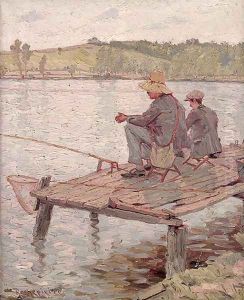Pierre Roche Paintings
Pierre Roche, born Henri-Pierre Roché on April 28, 1855, in Paris, France, was a multifaceted French artist best known for his work as a sculptor, but also recognized as a writer and art collector. His involvement in the art world extended beyond his own creations; he played a significant role in the promotion of avant-garde art during the late 19th and early 20th centuries.
Roche initially embarked on a career in diplomacy but his passion for art prevailed, leading him to pursue artistic endeavors. He studied at the École des Beaux-Arts in Paris and became proficient in various artistic mediums. However, he was particularly drawn to sculpture, and he developed a unique style that incorporated elements of Art Nouveau. His sculptures often featured graceful, flowing forms and were sometimes combined with other materials like glass to play with light and texture.
In addition to his sculptural work, Roche was a pivotal figure in the Parisian artistic milieu. He was friends with influential artists and writers of the time, including Henri de Toulouse-Lautrec, Edgar Degas, and the Stein siblings—Leo, Gertrude, and Michael. Through these connections, he became actively involved in the promotion and collection of modern art, including African and Oceanic art, which was then being discovered by European artists and having a profound influence on the development of modernist aesthetics.
Roche's own collection became notable, comprising works by prominent artists such as Pablo Picasso, whom he supported early in Picasso's career. Beyond the art world, Pierre Roche is also remembered for his literary work. He wrote two semi-autobiographical novels later in life, 'Jules et Jim' and 'Deux Anglaises et le Continent,' which gained fame posthumously when they were adapted into films by the French New Wave director François Truffaut.
Pierre Roche's contributions to the art world were not limited to his own artistic production but were augmented by his role as a patron and connector among artists and collectors. His keen eye for talent and his support for the avant-garde helped shape the direction of early modern art. Roche passed away on April 6, 1922, in Paris. His legacy is that of a man deeply embedded in the artistic transformations of his time, both through his own creative output and through his influential support of other artists.
